Joint Design of the Transmit Beampattern and Angular Waveform for Colocated MIMO Radar under a Constant Modulus Constraint
Abstract
:1. Introduction
- (1)
- Directional transmit beampattern design:
- (2)
- The power spectral density (PSD) design of AWs:
- (3)
- The design of AWs with spectral compatibility and similarity:
- (4)
- The waveform optimization algorithm for the proposed cost functions:
2. Signal Processing Scheme and the Role of the AW
3. Problem Formulation
3.1. Directional Transmit Beampattern Design
3.2. The Joint Design of the Transmit Beampattern and the PSDs of AWs
3.3. Joint Design of the Transmit Beampattern and the Spectral Compatibility and Similarity of AWs
4. Waveform Optimization Algorithm for the Joint Design
4.1. Proposed Algorithm
- (1)
- Update :
- (2)
- Update :
| Algorithm 1: Waveform optimization algorithm for the joint design. |
4.2. Algorithm Convergence
- (1)
- as , where . This means that the iterates approach feasibility;
- (2)
- as , where .
4.3. Reduce the Computational Complexity
5. Simulation Results
5.1. The Joint Design of the Transmit Beampattern and the PSDs of AWs
5.2. Joint Design of the Transmit Beampattern and AWs with Spectral Compatibility and Similarity
5.3. The Application of Problem (47) for AWs’ Orthogonality Design
6. Discussion: Quantitative Comparisons with Existing Algorithms
7. Conclusions
Author Contributions
Funding
Conflicts of Interest
Appendix A. The Calculation of
Appendix A
References
- Fuhrmann, D.; San Antonio, G. Transmit beamforming for MIMO radar systems using partial signal correlation. In Proceedings of the Conference Record of the Thirty-Eighth Asilomar Conference on Signals, Systems and Computers, Pacific Grove, CA, USA, 7–10 November 2004; Volume 1, pp. 295–299. [Google Scholar] [CrossRef]
- Fishler, E.; Haimovich, A.; Blum, R.; Cimini, R.; Chizhik, D.; Valenzuela, R. Performance of MIMO radar systems: Advantages of angular diversity. In Proceedings of the Conference Record of the Thirty-Eighth Asilomar Conference on Signals, Systems and Computers, Pacific Grove, CA, USA, 7–10 November 2004; Volume 1, pp. 305–309. [Google Scholar] [CrossRef]
- Robey, F.; Coutts, S.; Weikle, D.; McHarg, J.; Cuomo, K. MIMO radar theory and experimental results. In Proceedings of the Conference Record of the Thirty-Eighth Asilomar Conference on Signals, Systems and Computers, Pacific Grove, CA, USA, 7–10 November 2004; pp. 300–304. [Google Scholar] [CrossRef]
- Haimovich, A.M.; Blum, R.S.; Cimini, L.J. MIMO Radar with Widely Separated Antennas. IEEE Signal Process. Mag. 2008, 25, 116–129. [Google Scholar] [CrossRef]
- Li, J.; Stoica, P. MIMO Radar with Colocated Antennas. IEEE Signal Process. Mag. 2007, 24, 106–114. [Google Scholar] [CrossRef]
- Zhou, S.; Liu, H.; Hongtao Su, H.Z. Doppler sensitivity of MIMO radar waveforms. IEEE Trans. Aerosp. Electron. Syst. 2016, 52, 2091–2110. [Google Scholar] [CrossRef]
- Xu, L.; Zhou, S.; Liu, H.; Zang, H.; Ma, L. Distributed multiple-input multiple-output radar waveform and mismatched filter design with expanded mainlobe. IET Radar Sonar Navig. 2018, 12, 227–238. [Google Scholar] [CrossRef]
- Deng, H.; Geng, Z.; Himed, B. MIMO radar waveform design for transmit beamforming and orthogonality. IEEE Trans. Aerosp. Electron. Syst. 2016, 52, 1421–1433. [Google Scholar] [CrossRef]
- Khan, H.; Zhang, Y.; Ji, C.; Stevens, C.; Edwards, D.; O’Brien, D. Optimizing Polyphase Sequences for Orthogonal Netted Radar. IEEE Signal Process. Lett. 2006, 13, 589–592. [Google Scholar] [CrossRef]
- Li, H.; Zhao, Y.; Cheng, Z.; Feng, D. Correlated LFM Waveform Set Design for MIMO Radar Transmit Beampattern. IEEE Geosci. Remote. Sens. Lett. 2017, 14, 329–333. [Google Scholar] [CrossRef]
- Cheng, Z.; He, Z.; Zhang, S.; Jian, L. Constant Modulus Waveform Design for MIMO Radar Transmit Beampattern. IEEE Trans. Signal Process. 2017, 65, 4912–4923. [Google Scholar] [CrossRef]
- Liu, H.; Zhou, S.; Zang, H.; Cao, Y. Two waveform design criteria for colocated MIMO radar. In Proceedings of the 2014 International Radar Conference, Lille, France, 13–17 October 2014; pp. 1–5. [Google Scholar] [CrossRef]
- Song, J.; Babu, P.; Palomar, D.P. Sequence Set Design with Good Correlation Properties Via Majorization-Minimization. IEEE Trans. Signal Process. 2016, 64, 2866–2879. [Google Scholar] [CrossRef] [Green Version]
- Stoica, P.; He, H.; Li, J. New Algorithms for Designing Unimodular Sequences with Good Correlation Properties. IEEE Trans. Signal Process. 2009, 57, 1415–1425. [Google Scholar] [CrossRef] [Green Version]
- Friedlander, B. On Transmit Beamforming for MIMO Radar. IEEE Trans. Aerosp. Electron. Syst. 2012, 48, 3376–3388. [Google Scholar] [CrossRef]
- Shi, J.; Bo, J.; Liu, H.; Ming, F.; Yan, J. Transmit design for airborne MIMO radar based on prior information. Signal Process. 2016, 128, 521–530. [Google Scholar] [CrossRef]
- Yan, J.; Liu, H.; Jiu, B.; Chen, B.; Liu, Z.; Bao, Z. Simultaneous Multibeam Resource Allocation Scheme for Multiple Target Tracking. IEEE Trans. Signal Process. 2015, 63, 3110–3122. [Google Scholar] [CrossRef]
- Yan, J.; Jiu, B.; Liu, H.; Chen, B.; Bao, Z. Prior Knowledge-Based Simultaneous Multibeam Power Allocation Algorithm for Cognitive Multiple Targets Tracking in Clutter. IEEE Trans. Signal Process. 2015, 63, 512–527. [Google Scholar] [CrossRef]
- Yu, X.; Cui, G.; Zhang, T.; Kong, L. Constrained transmit beampattern design for colocated MIMO radar. Signal Process. 2018, 144, 145–154. [Google Scholar] [CrossRef]
- Cheng, Z.; Han, C.; Liao, B.; He, Z.; Li, J. Communication-Aware Waveform Design for MIMO Radar With Good Transmit Beampattern. IEEE Trans. Signal Process. 2018, 66, 5549–5562. [Google Scholar] [CrossRef]
- Zhou, S.; Lu, J.; Varshney, P.K.; Wang, J.; Liu, H. Colocated MIMO radar waveform optimization with receive beamforming. Digit. Signal Process. 2019, 98, 102635. [Google Scholar] [CrossRef]
- Zheng, H.; Jiu, B.; Liu, H. Joint Optimization of Transmit Waveform and Receive Filter for Target Detection in MIMO Radar. IEEE Access 2019, 7, 184923–184939. [Google Scholar] [CrossRef]
- Wang, J.; Wang, Y. On the Design of Constant Modulus Probing Waveforms With Good Correlation Properties for MIMO Radar via Consensus-ADMM Approach. IEEE Trans. Signal Process. 2019, 67, 4317–4332. [Google Scholar] [CrossRef]
- Wang, Y.C.; Xu, W.; Liu, H.; Luo, Z.Q. On the Design of Constant Modulus Probing Signals for MIMO Radar. IEEE Trans. Signal Process. 2012, 60, 4432–4438. [Google Scholar] [CrossRef]
- Liu, H.; Wang, X.; Jiu, B.; Yan, J.; Wu, M.; Bao, Z. Wideband MIMO Radar Waveform Design for Multiple Target Imaging. IEEE Sens. J. 2016, 16, 8545–8556. [Google Scholar] [CrossRef]
- Gajic, A.; Radovanovic, J.; Vukovic, N.; Milanovic, V.; Boiko, D.L. Theoretical Approach to Quantum Cascade Micro-Laser Broadband Multimode Emission in Strong Magnetic Fields. Phys. Lett. A 2021, 387, 127007. [Google Scholar]
- Lionis, A.; Peppas, K.; Nistazakis, H.E.; Tsigopoulos, A.D.; Cohn, K. Experimental Performance Analysis of an Optical Communication Channel over Maritime Environment. Electronics 2020, 9, 1109. [Google Scholar] [CrossRef]
- Garlinska, M.; Pregowska, A.; Gutowska, I.; Osial, M.; Szczepanski, J. Experimental Study of the Free Space Optics Communication System Operating in the 8–12 μm Spectral Range. Electronics 2021, 10, 875. [Google Scholar] [CrossRef]
- Wang, Y.; Xu, H.; Li, D.; Wang, R.; Jin, C.; Yin, X.; Gao, S.; Mu, Q.; Xuan, L.; Cao, Z. Performance analysis of an adaptive optics system for free-space optics communication through atmospheric turbulence. Sci. Rep. 2018, 8, 1124. [Google Scholar] [CrossRef] [PubMed]
- Li, K.; Jiu, B.; Liu, H. Game Theoretic Strategies Design for Monostatic Radar and Jammer Based on Mutual Information. IEEE Access 2019, 7, 72257–72266. [Google Scholar] [CrossRef]
- Lan, X.; Li, W.; Wang, X.; Yan, J.; Jiang, M. MIMO Radar and Target Stackelberg Game in the Presence of Clutter. IEEE Sens. J. 2015, 15, 6912–6920. [Google Scholar] [CrossRef]
- Kim, H.; Goodman, N.A.; Lee, C.K.; Yang, S. Improved waveform design for radar target classification. Electron. Lett. 2017, 53, 879–881. [Google Scholar] [CrossRef] [Green Version]
- Garren, D.A.; Odom, A.C.; Osborn, M.K.; Goldstein, J.S.; Pillai, S.U.; Guerci, J.R. Full-polarization matched-illumination for target detection and identification. IEEE Trans. Aerosp. Electron. Syst. 2002, 38, 824–837. [Google Scholar] [CrossRef]
- Tang, B.; Liang, J. Efficient Algorithms for Synthesizing Probing Waveforms With Desired Spectral Shapes. IEEE Trans. Aerosp. Electron. Syst. 2019, 55, 1174–1189. [Google Scholar] [CrossRef]
- Rowe, W.; Stoica, P.; Li, J. Spectrally Constrained Waveform Design [sp Tips Tricks]. IEEE Signal Process. Mag. 2014, 31, 157–162. [Google Scholar] [CrossRef]
- Bo, T.; Jian, L.; Junli, L. Alternating direction method of multipliers for radar waveform design in spectrally crowded environments. Signal Process. 2018, 142, 398–402. [Google Scholar]
- Boyd, S.; Parikh, N.; Chu, E.; Peleato, B.; Eckstein, J. Distributed Optimization and Statistical Learning via the Alternating Direction Method of Multipliers. Found. Trends Mach. Learn. 2011, 3, 1–122. [Google Scholar] [CrossRef]
- Xiao, Y.; Li, T.F.; Wei, Z.X. Global Convergence of a Modified Limited Memory BFGS Method for Non-convex Minimization. Acta Math. Appl. Sin. 2013, 29. [Google Scholar] [CrossRef]
- Bo, J.; Liu, H.; Xu, W.; Lei, Z.; Wang, Y.; Bo, C. Knowledge-Based Spatial-Temporal Hierarchical MIMO Radar Waveform Design Method for Target Detection in Heterogeneous Clutter Zone. IEEE Trans. Signal Process. 2014, 63, 543–554. [Google Scholar]
- Boyd, S.; Vandenberghe, L. Convex Optimization; Cambridge University Press: Cambridge, UK, 2004. [Google Scholar]
- Song, J.; Babu, P.; Palomar, D.P. Sequence Design to Minimize the Weighted Integrated and Peak Sidelobe Levels. IEEE Trans. Signal Process. 2016, 64, 2051–2064. [Google Scholar] [CrossRef] [Green Version]


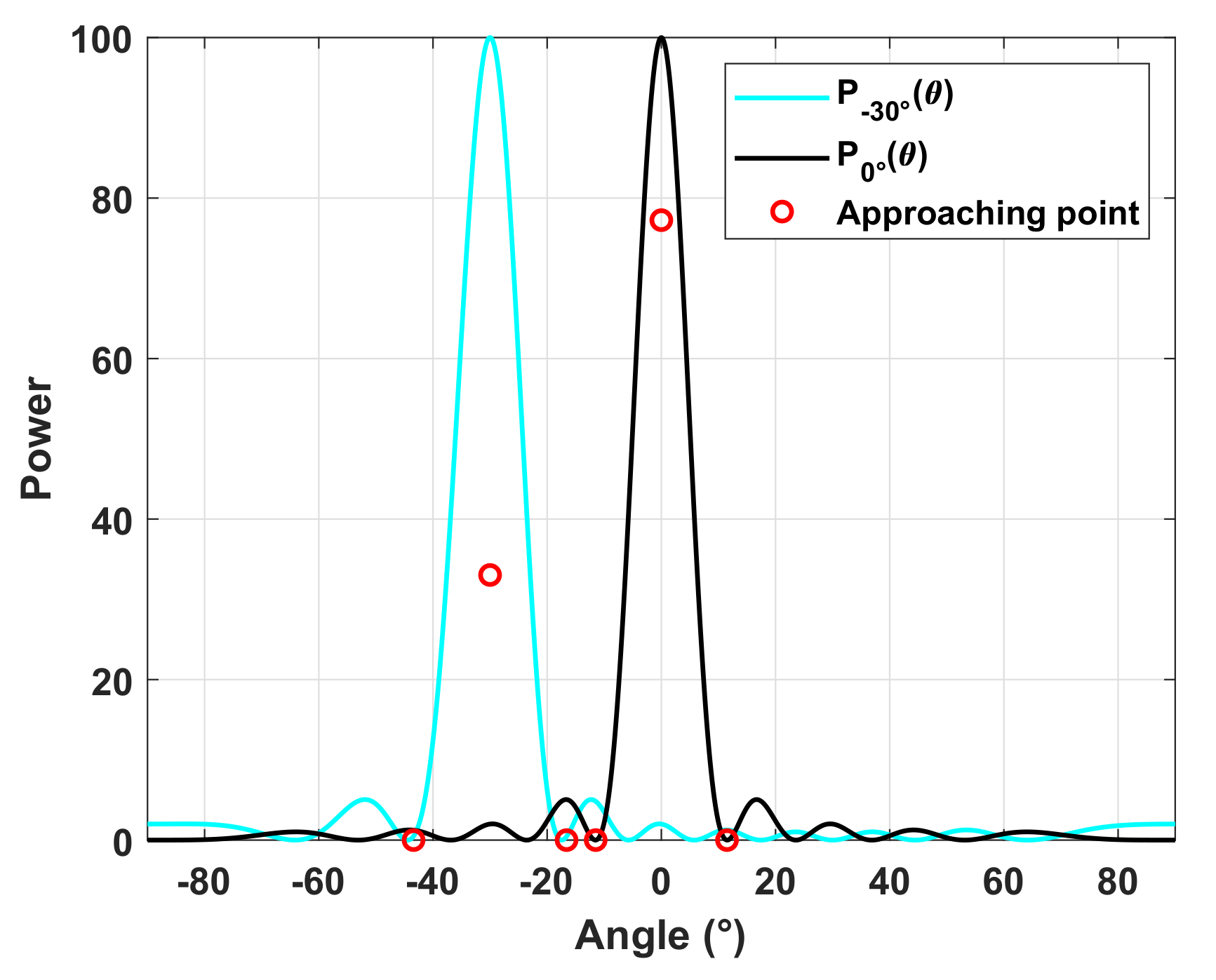


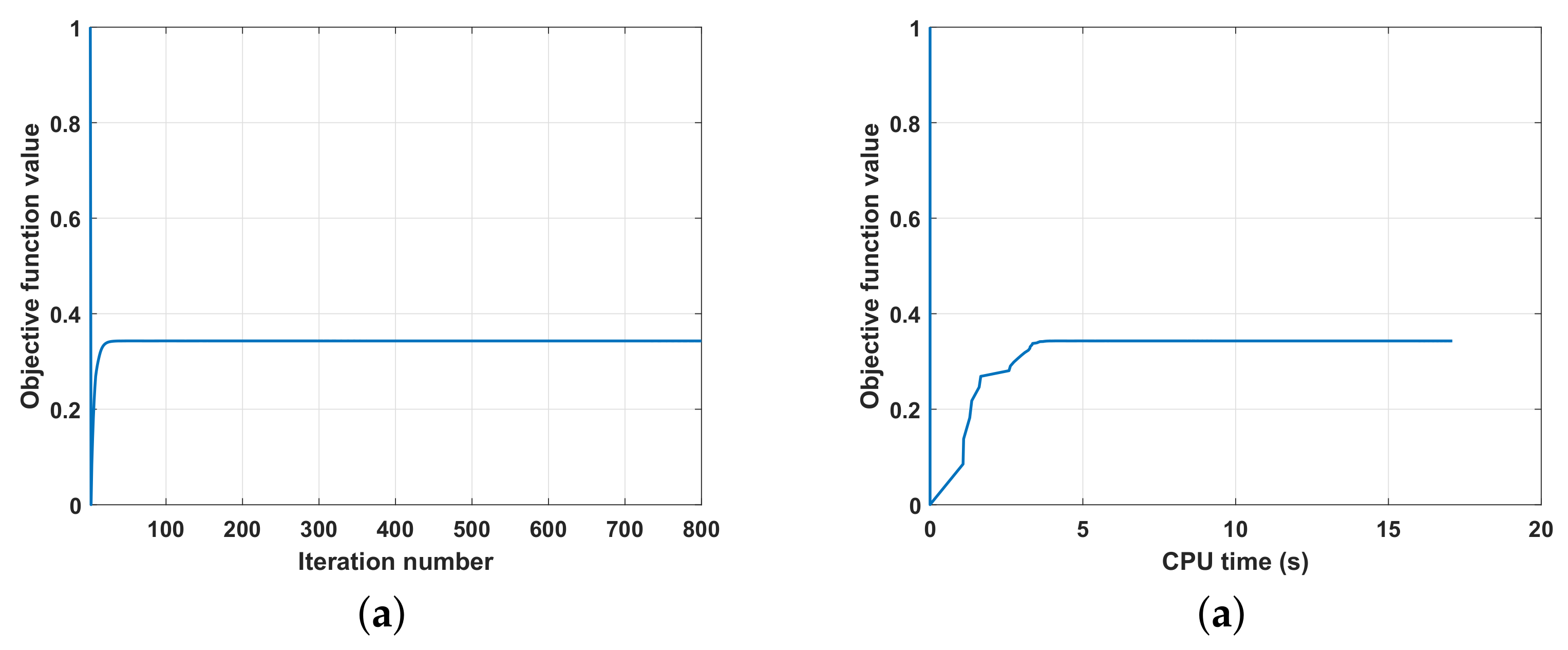
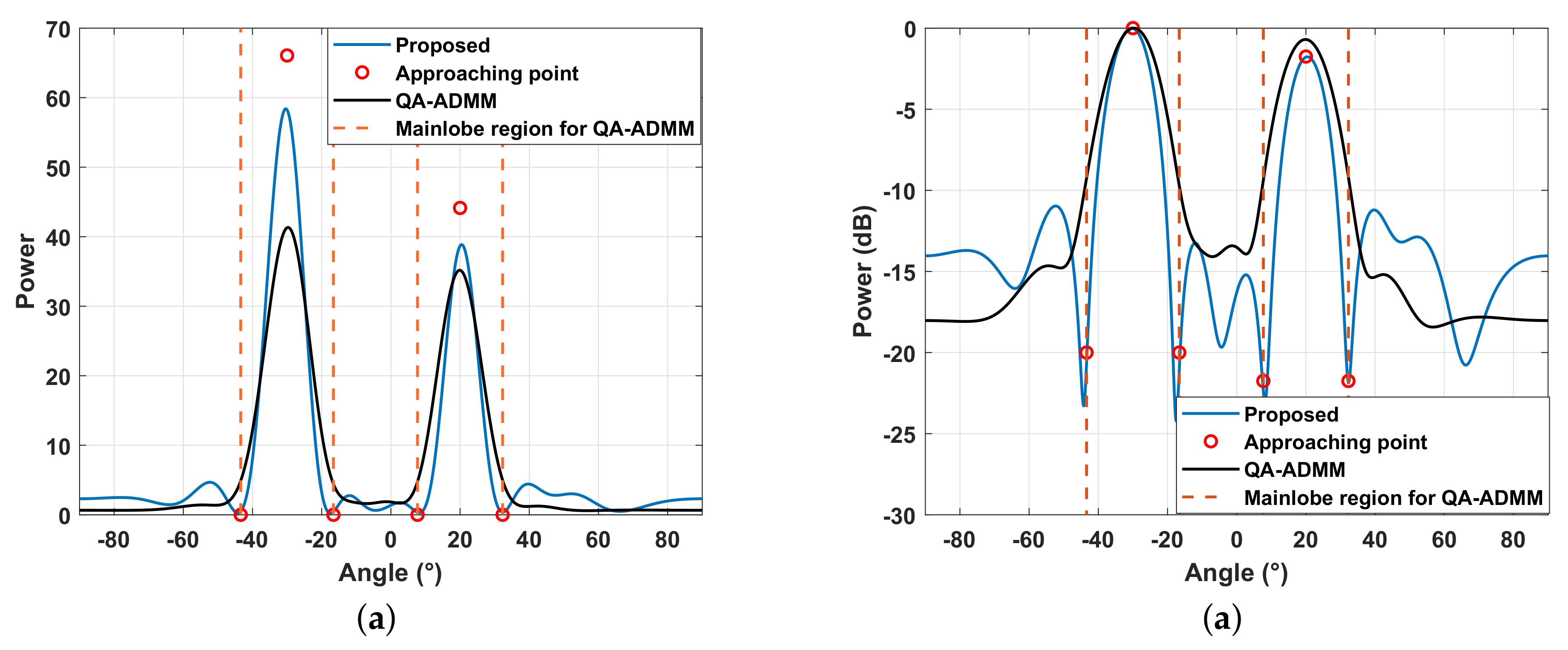
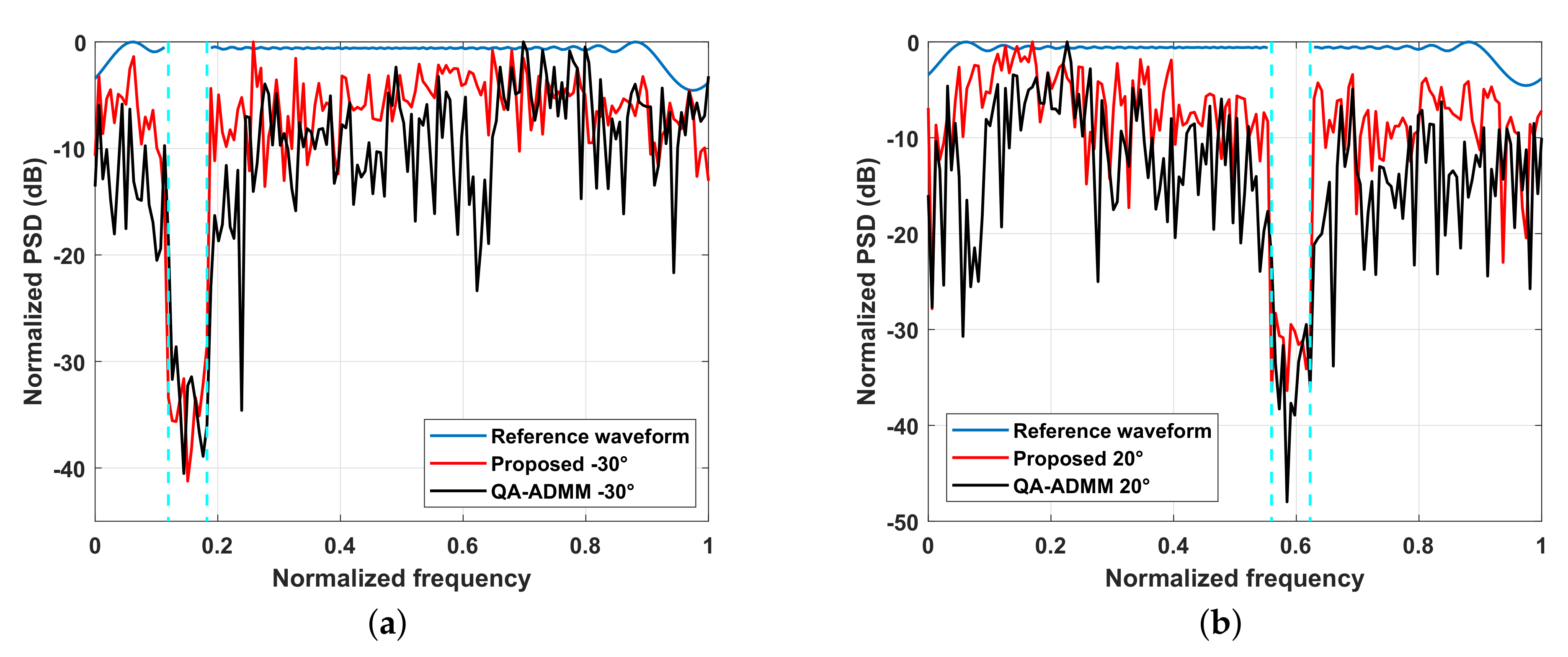
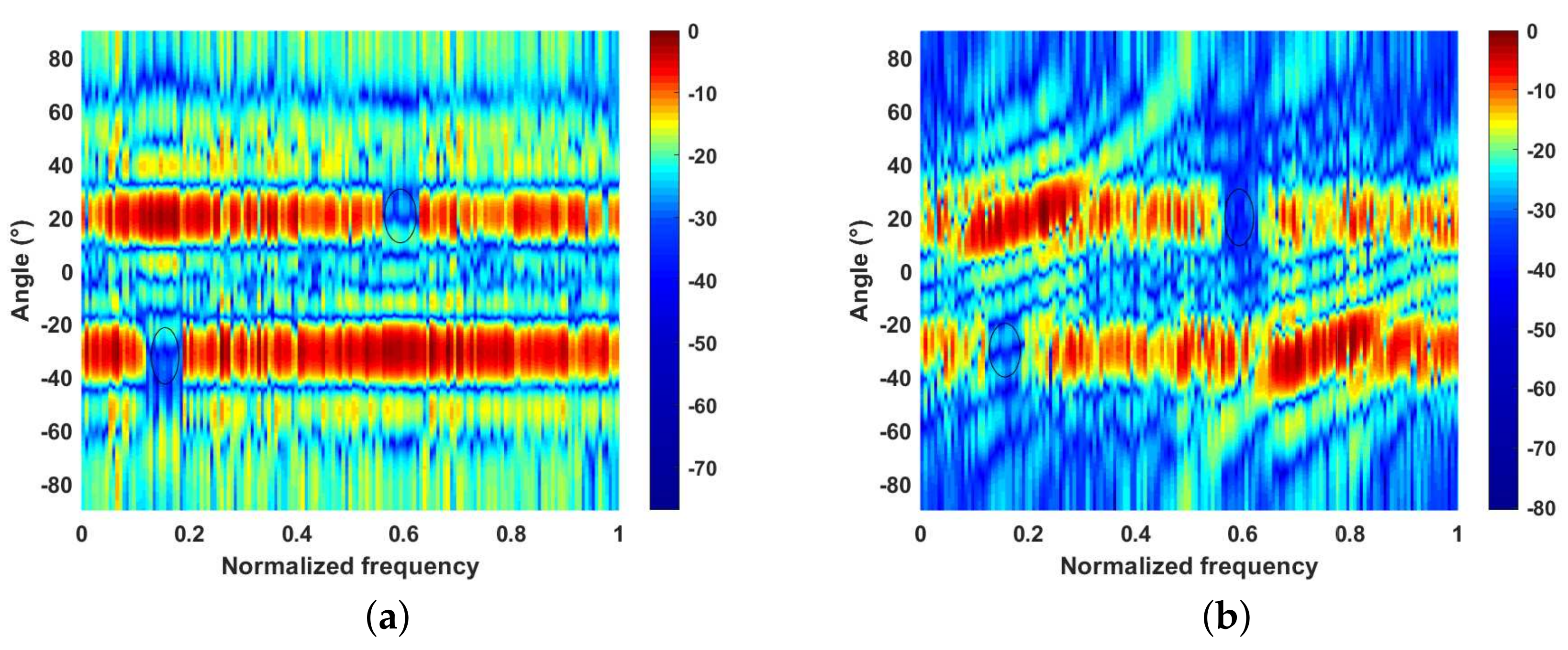
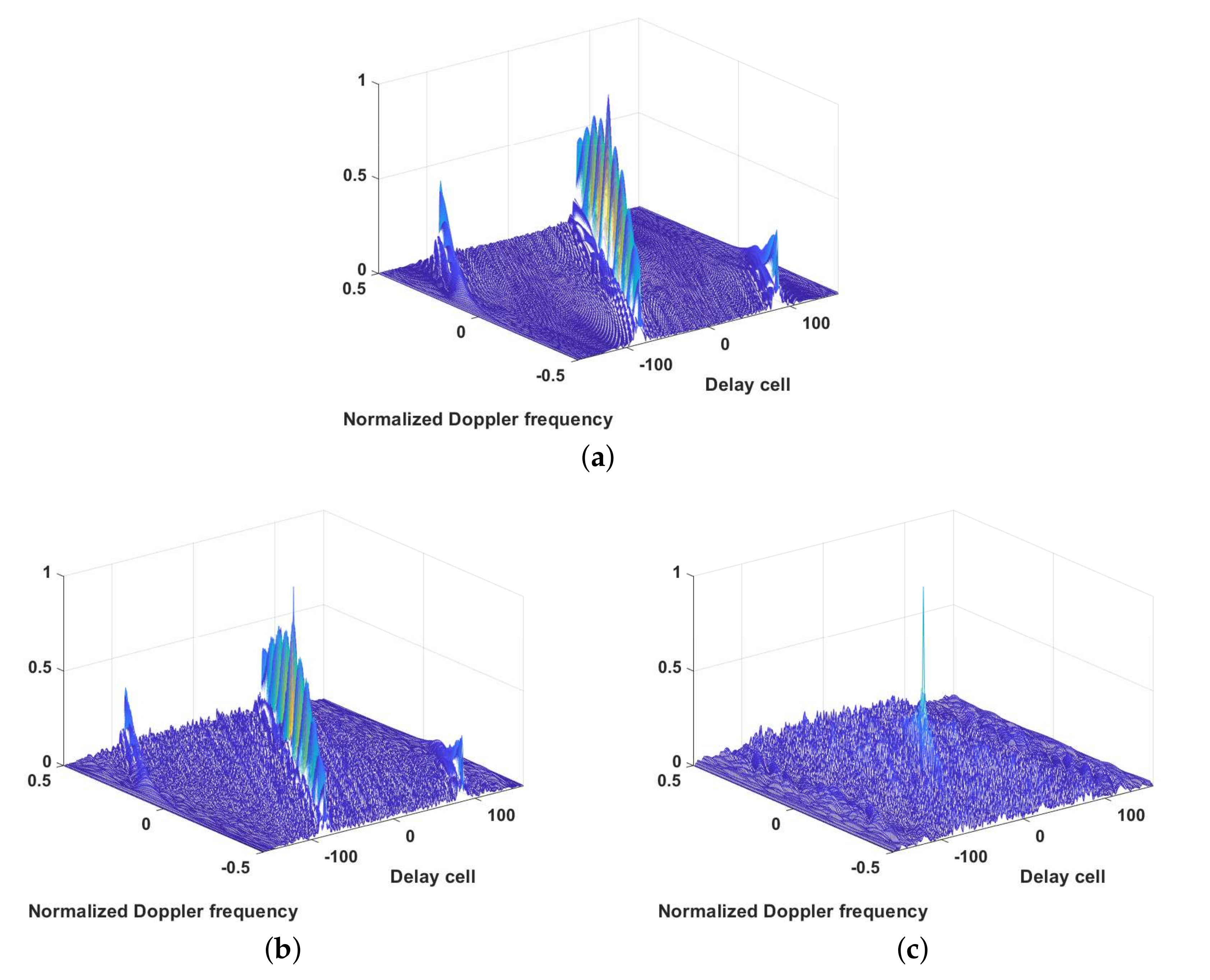
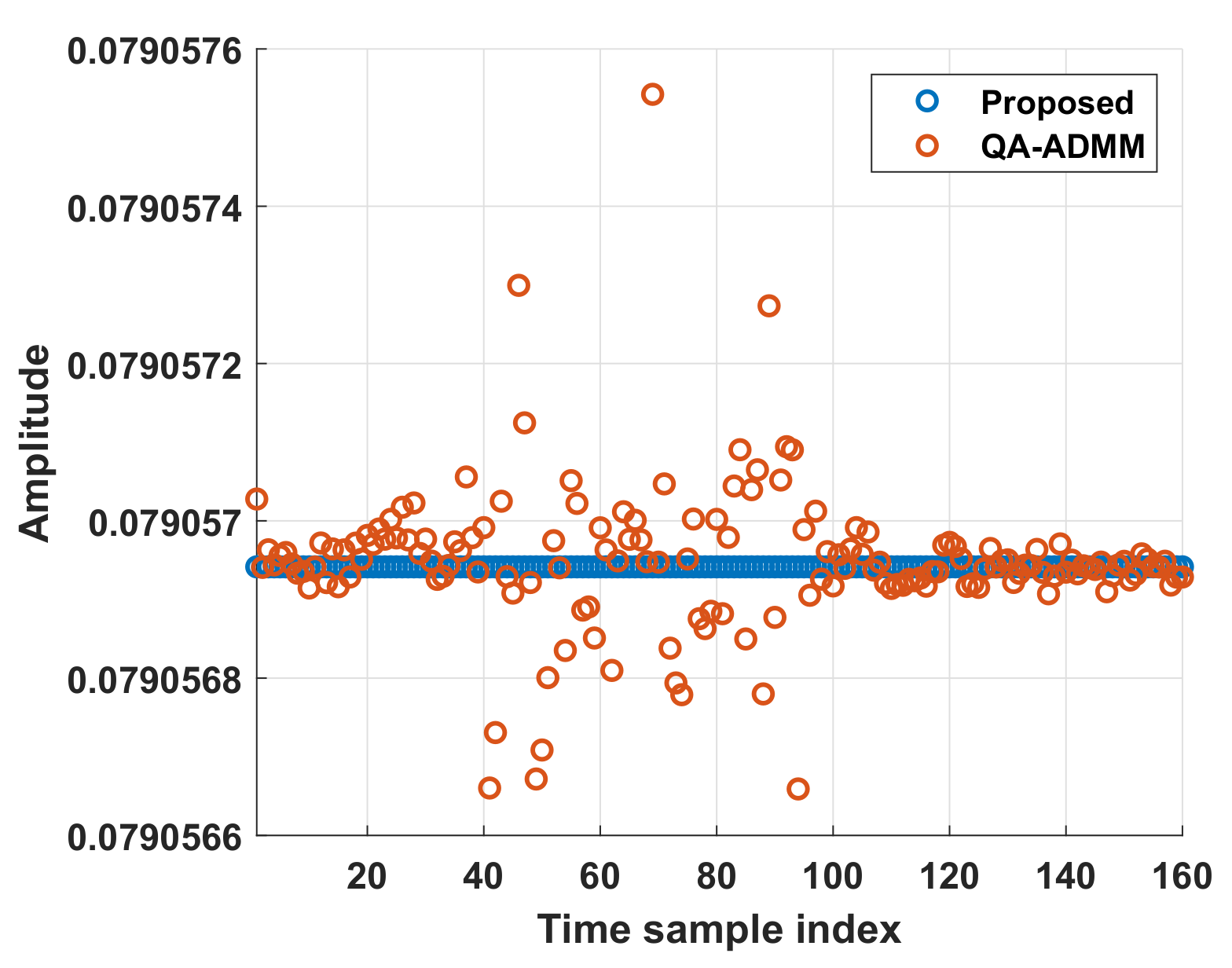
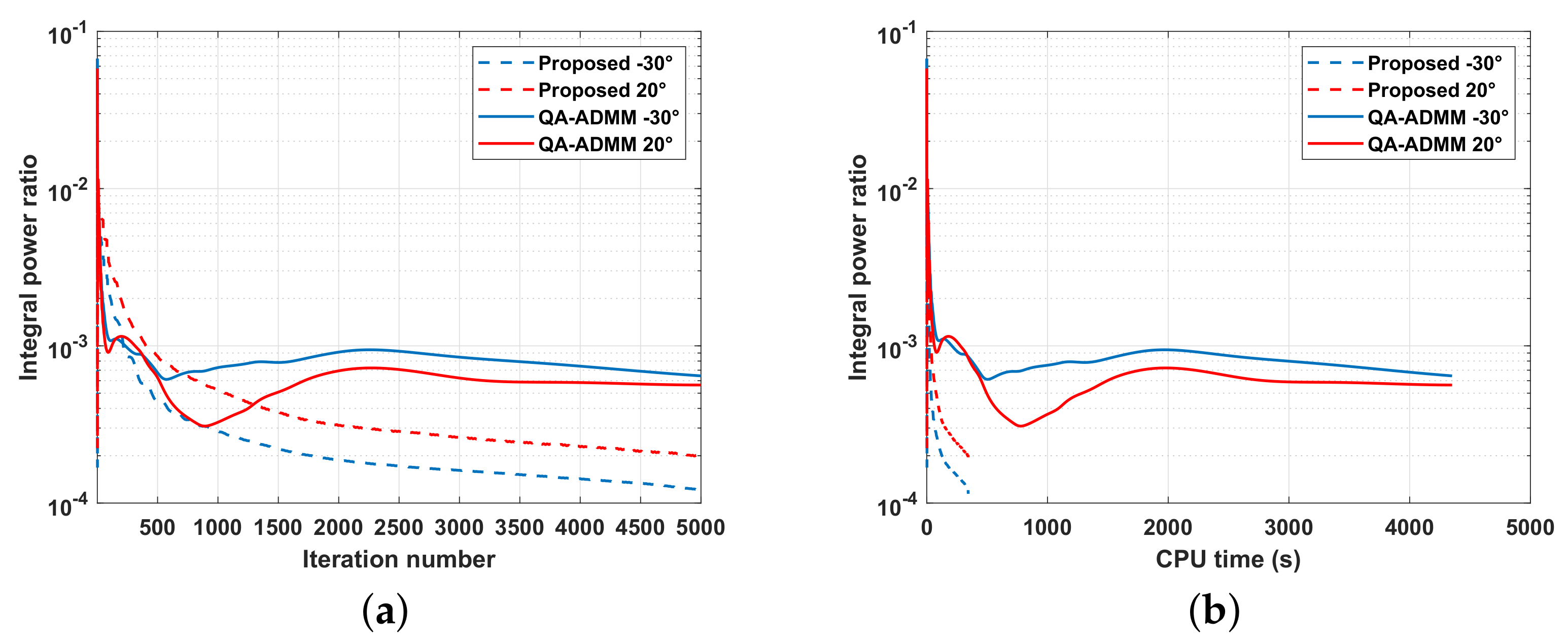
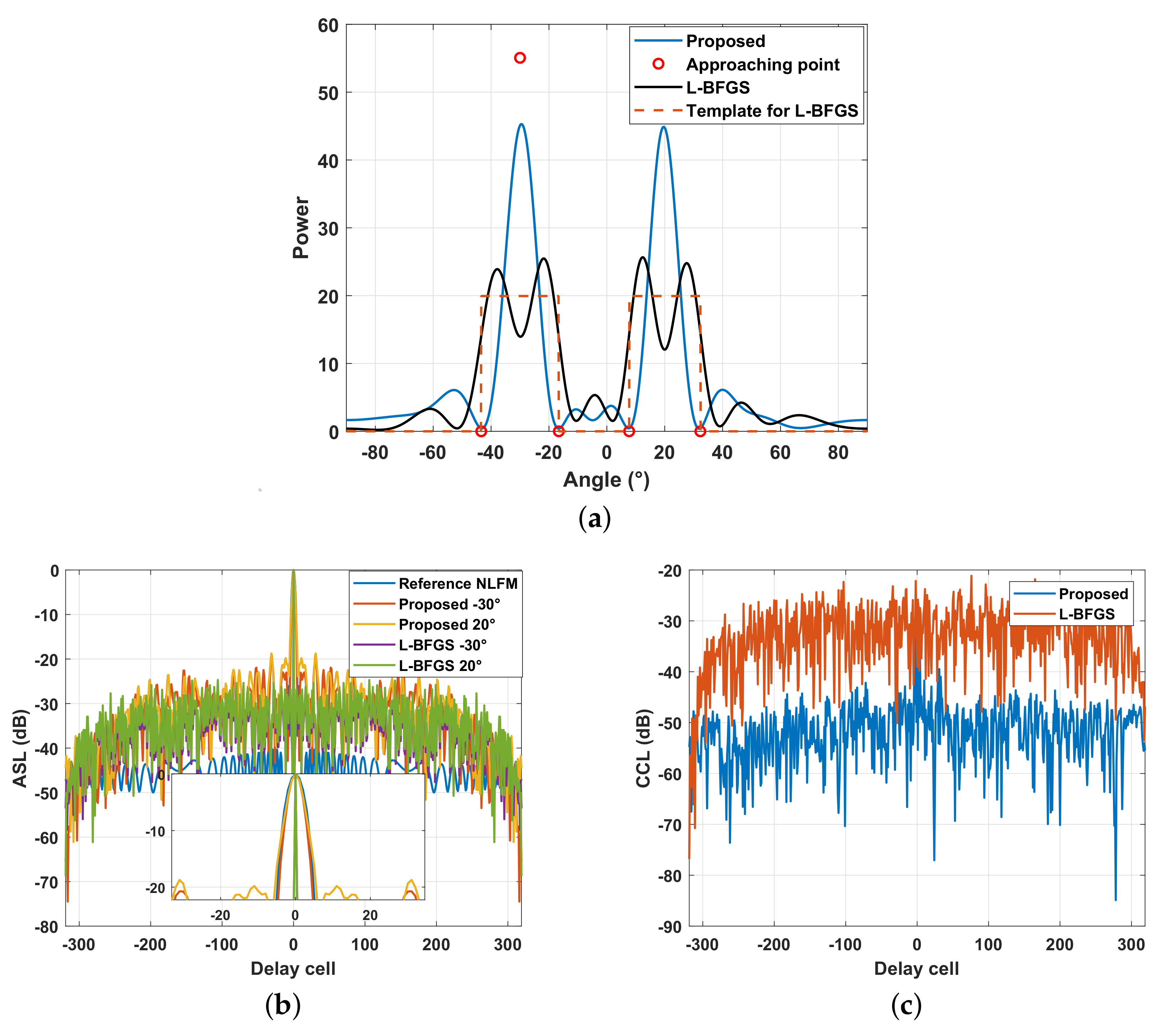
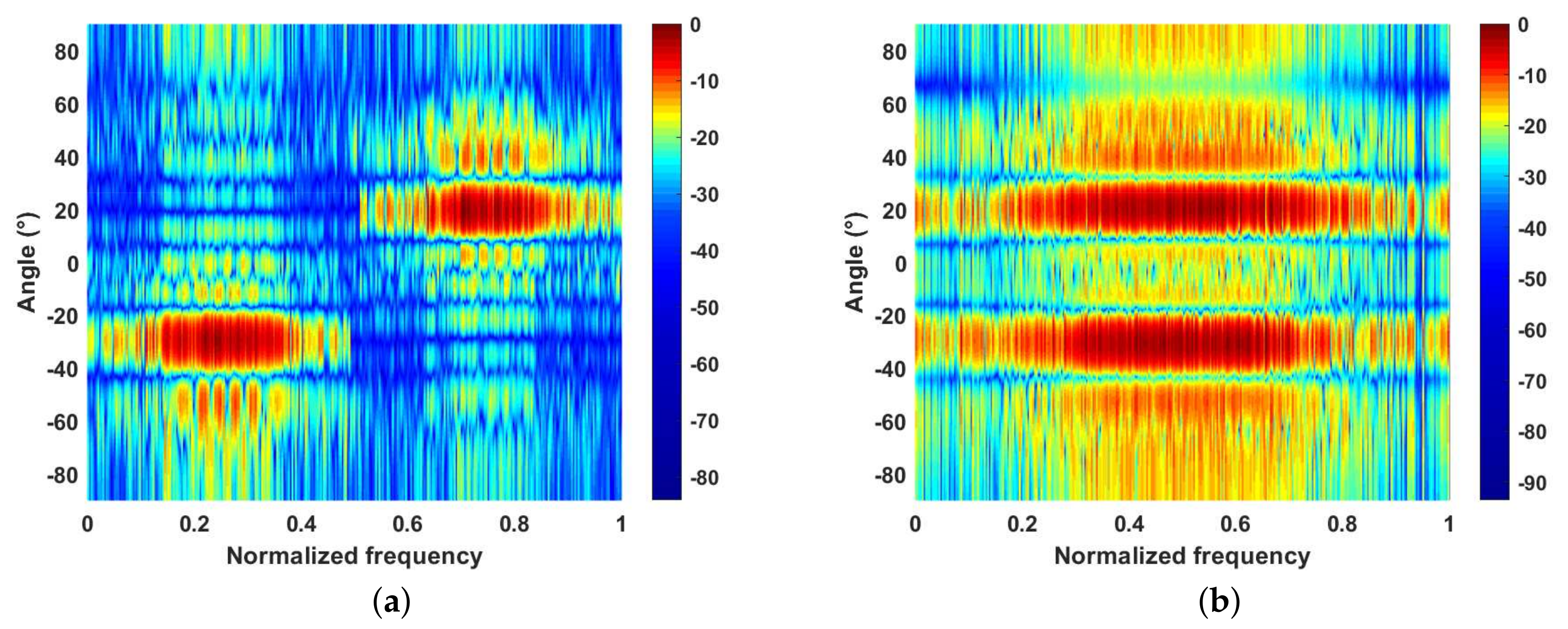

| M | L | OFV | ETPI (s) | ||
|---|---|---|---|---|---|
| 10 | 64 | 48.57 | 48.66 | 0.34 | 0.026 |
| 20 | 128 | 193.37 | 193.46 | 0.35 | 0.15 |
| 30 | 192 | 437.22 | 437.45 | 0.35 | 0.57 |
| Algorithm | M | L | ETPI (s) | ||||||
|---|---|---|---|---|---|---|---|---|---|
| 10 | 64 | 58.22 | 39.04 | 2.16 | 5.79 | 0.15 | 0.24 | 0.012 | |
| Proposed | 20 | 128 | 233.43 | 153.44 | 2.34 | 4.69 | 0.19 | 0.27 | 0.14 |
| 30 | 192 | 522.31 | 340.98 | 2.47 | 5.52 | 0.24 | 0.29 | 0.72 | |
| 10 | 64 | 37.28 | 38.06 | 11.8 | 92.6 | 1.52 | 1.78 | 0.11 | |
| QA-ADMM | 20 | 128 | 128.31 | 127.73 | 22.3 | 30.7 | 1.64 | 1.98 | 3.13 |
| 30 | 192 | 297.33 | 287.01 | 49.0 | 107 | 1.66 | 1.84 | 24.28 |
| Algorithm | M | L | PASL (dB) | ETPI (s) | ||
|---|---|---|---|---|---|---|
| 10 | 192 | 46.62 | 47.17 | −21.2 | 0.11 | |
| Proposed | 20 | 256 | 187.49 | 187.94 | −24.31 | 0.64 |
| 30 | 320 | 410.08 | 414.24 | −24.63 | 2.12 | |
| 10 | 192 | 13.82 | 12.02 | −20.6 | 0.076 | |
| L-BFGS | 20 | 256 | 68.15 | 67.38 | −23.96 | 0.41 |
| 30 | 320 | 70.92 | 69.14 | −24.15 | 1.36 |
Publisher’s Note: MDPI stays neutral with regard to jurisdictional claims in published maps and institutional affiliations. |
© 2021 by the authors. Licensee MDPI, Basel, Switzerland. This article is an open access article distributed under the terms and conditions of the Creative Commons Attribution (CC BY) license (https://creativecommons.org/licenses/by/4.0/).
Share and Cite
Zheng, H.; Jiu, B.; Li, K.; Liu, H. Joint Design of the Transmit Beampattern and Angular Waveform for Colocated MIMO Radar under a Constant Modulus Constraint. Remote Sens. 2021, 13, 3392. https://doi.org/10.3390/rs13173392
Zheng H, Jiu B, Li K, Liu H. Joint Design of the Transmit Beampattern and Angular Waveform for Colocated MIMO Radar under a Constant Modulus Constraint. Remote Sensing. 2021; 13(17):3392. https://doi.org/10.3390/rs13173392
Chicago/Turabian StyleZheng, Hao, Bo Jiu, Kang Li, and Hongwei Liu. 2021. "Joint Design of the Transmit Beampattern and Angular Waveform for Colocated MIMO Radar under a Constant Modulus Constraint" Remote Sensing 13, no. 17: 3392. https://doi.org/10.3390/rs13173392





